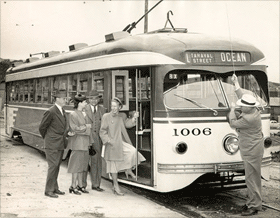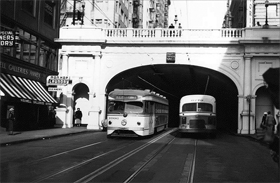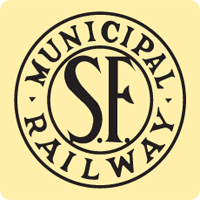When the Presidents’ Conference Committee (PCC) of U.S. street railway executives got together in the early 1930s to design a better streetcar, they wanted to get away from the boxy double-ended streetcars that then ruled the streets, opting instead for a streamlined, single-end design that was more automotive in look. This single-end “PCC” streetcar would require streetcar operators to install loop tracks or switches in the shape of a “Y” to turn the cars back at the ends of lines, but this was considered a fair tradeoff.

Not for everyone, though. The San Francisco Municipal Railway required that its first two orders of streamlined streetcars be double-ended: the five so-called “Magic Carpet” cars of 1939 (PCC-lookalikes with different operating systems, whose livery is modeled by car No. 1010 today); and the 10 true PCC-equipped streamliners delivered to Muni in 1948.
This class of streetcars, numbered from 1006 to 1015, were known at Muni as “Torpedoes” because of their shape, and later also known as the “Big Tens” to distinguish them from the 25 smaller single-end PCCs, numbered from 1016 to 1040, which were known as the “Baby Tens.”
 No. 1006 on the original F-Stockton streetcar line. The Stockton Tunnel was originally built for streetcars.
No. 1006 on the original F-Stockton streetcar line. The Stockton Tunnel was originally built for streetcars.
The Big Tens were among the largest PCC streetcars ever built, exceeded in length only by Chicago’s single-end behemoths. They were delivered in what was then a brand-new livery for Muni: green bodies with cream trim, including fingers of cream extending toward the center of the car from each door. This was quickly dubbed the “Wings” livery, and it was eventually applied to every Muni streetcar and bus by about 1950.
The mystery of Muni’s insistence on double-ended modern streetcar was deepened by the routes they were almost always assigned to: those with track loops at both ends, making double-end cars unnecessary. Just as the double-end “Magic Carpet” streetcars usually served the loop-equipped L-Taraval, so the new “Torpedoes” found their first home on the N-Judah, sometimes making a trip on the B-Geary first (both loop lines).
By the mid-1950s, Muni converted its 15 modern double-end cars to operate as single-enders, by sealing the doors on one side. Around this time, these cars were painted to match the single-end PCCs, with the “Wings” only stretching back from the now-front doors.
In 2010-11, Muni restored two of its original Torpedoes to their original 1948 livery. No. 1006 operated through the end of regular Muni PCC service in 1982, and was then reconverted to a double-end car for service in the Trolley Festivals of the mid-1980s.
No. 1008 was reconverted to operate from either end in the 1980s as well — but as a service car, towing broken-down cars on the street and carrying out tasks in the Muni Metro Subway after hours (for which it was fitted with a pantograph, removed in the restoration).
These two San Francisco originals, resplendent again in their 1948 Wings livery, returned to service in time for Muni’s centennial at the end of 2012.
 Originally built for
Originally built forSan Francisco Municipal Railway, San Francisco CA, 1948
Builder
St. Louis Car Co.
Modified/upgraded
2010-11
Contractor
Brookville Equipment Company, Pennsylvania
Seats
60
Weight
40,140 lbs.
Length
50′ 5″
Width
9′ 0″
Height
10′ 1″
Motors
4 General Electric 1220E1
Control
General Electric
Trucks
St. Louis B-3
Brakes
Westinghouse Electric
